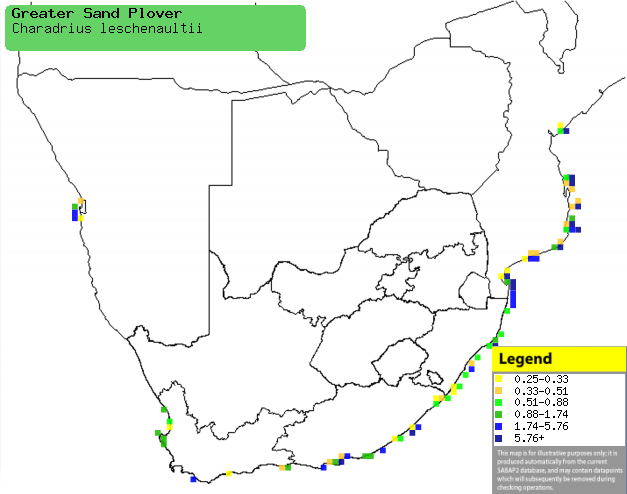|
Charadrius leschenaultii
(Greater sand plover, Sand plover)
Grootstrandkiewiet [Afrikaans]; Woestijnplevier [Dutch];
Pluvier de Leschenault [French]; Wüstenregenpfeifer [German];
Borrelho-do-deserto [Portuguese]
Life
> Eukaryotes >
Opisthokonta
> Metazoa (animals) >
Bilateria >
Deuterostomia > Chordata >
Craniata > Vertebrata (vertebrates) > Gnathostomata (jawed
vertebrates) > Teleostomi (teleost fish) > Osteichthyes (bony fish) > Class:
Sarcopterygii (lobe-finned
fish) > Stegocephalia (terrestrial
vertebrates) > Tetrapoda
(four-legged vertebrates) > Reptiliomorpha > Amniota >
Reptilia (reptiles) >
Romeriida > Diapsida > Archosauromorpha > Archosauria >
Dinosauria
(dinosaurs) > Saurischia > Theropoda (bipedal predatory dinosaurs) >
Coelurosauria > Maniraptora > Aves
(birds) >
Order: Charadriiformes > Family: Charadriidae
> Genus: Charadrius
Distribution and habitat
Breeds from Turkey to Mongolia, heading south in the
non-breeding season to southern Asia, Australia, the Malagasy region, Persion
Gulf and the east coast of Africa. In southern Africa it is uncommon
along the coast of Mozambique and South Africa, with an isolated population on
the central Namibia coast. It generally prefers mixed
sand and mud along the margins of estuaries and tidal lagoons, occasionally
moving to coastal dunes.
|
 |
|
Distribution of Greater sand plover in southern Africa,
based on statistical smoothing of the records from first SA Bird Atlas
Project (©
Animal Demography unit, University of
Cape Town; smoothing by Birgit Erni and Francesca Little). Colours range
from dark blue (most common) through to yellow (least common).
See here for the latest distribution
from the SABAP2. |
Movements and migrations
Birds in southern Africa originate from central
Asia, arriving in southern Africa from September and staying until
about April-May.
Food
It mainly eats fairly large invertebrates, doing most of
its foraging using the typical technique of plovers, running for about 10
seconds, stopping then searching for prey before repeating the process. The following food items have been recorded
in its diet:
- Invertebrates
- Upogebia africana (Estuarine mudprawn)
- small crabs
- Dotilla fenestrata (Army crab)
- Cleistosoma
- Uca vocans (Fiddler crabs)
- polychaetes
- worms
- molluscs
Threats
Not threatened, although destruction of
steppe habitat at its breeding grounds is cause for concern.
References
-
Hockey PAR, Dean WRJ and Ryan PG 2005. Roberts
- Birds of southern Africa, VIIth ed. The Trustees of the John Voelcker
Bird Book Fund, Cape Town.
|
